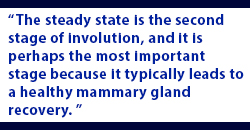
The stages of involution and an effective dry period
 By Sarah Adamson, Vita Plus dairy goat specialist
By Sarah Adamson, Vita Plus dairy goat specialist
Involution isn’t a common term for many of us. By definition, involution is the process of an organ shrinking after an extended period of inactivity. For the purposes of this article, involution will be used to refer to the process the mammary gland undergoes to return to its non-lactating state.
Involution occurs during a doe’s dry period and occurs in three stages. While most producers know it is important to give their does a dry period to let the mammary system recover, many only give them 40 days, which may not be long enough. Research shows the three stages of involution take between 40 and 60 days to complete before a doe is ready to be an efficient producer again. To explain why it is important to give your does a longer dry period, we’ll break down what happened during the three stages of involution on a biological level.
Active involution
The first stage is active involution and marks the transition from lactating to non-lactating. It begins when a doe has not been milked in 24 hours and typically lasts about three to four weeks. After a long period of inactivity, such as from drying off or weaning the offspring, the milk and formation of other substances in the stored milk sends a chemical feedback. This causes mechanical stress inside of the mammary system and the stretching of the mammary cells, which leads to the inability to secrete milk.
In other words, when milk doesn’t get removed from the udder, the mammary system becomes stressed and loses its ability to secrete milk.
Steady state involution
This is the second stage of involution, and it is perhaps the most important stage because it typically leads to a healthy mammary gland recovery. After drying off, only a small amount of fluid volume is left in the mammary gland, giving the gland a chance to rest and heal properly as well as allowing the teats to seal. If you have ever milked out a doe directly after kidding, you’ve probably noticed what I have typically referred to as the colostrum plug. This is a keratin plug that forms within the teat canal during steady state involution. This plug significantly lowers the chance of new infections developing during this period, making it the stage of involution with the lowest risk of developing new infections and mastitis.
 During this stage, the mammary gland secretes a high level of lactoferrin. Lactoferrin is a protein found in the gland during involution and helps with disease resistance. While the degree to which the fully involuted udder can resist new infection may vary depending on the bacterial species and immune function of the goat, an acute clinical case of mastitis is seldomly observed in an udder that has reached, and gone through, steady state involution.
During this stage, the mammary gland secretes a high level of lactoferrin. Lactoferrin is a protein found in the gland during involution and helps with disease resistance. While the degree to which the fully involuted udder can resist new infection may vary depending on the bacterial species and immune function of the goat, an acute clinical case of mastitis is seldomly observed in an udder that has reached, and gone through, steady state involution.
Redevelopment and colostrogenesis
This last stage of involution starts two to three weeks prior to parturition when the doe starts to produce colostrum. Having a low-stress environment during this stage is important so the doe can maintain a healthy immune system, which is critical to producing high-quality colostrum.
Conclusion
If we take into consideration the mandatory three to four weeks for active involution, and the mandatory two to three weeks for redevelopment and colostrogenesis, those two stages alone take between 35 to 49 days to complete. If you currently have your does on a 40-day dry period, you may not be giving your does adequate time to recover from milk production. They may not even have enough time to complete steady state involution, the stage where some of the most important recovery happens.
While having too long of a dry period is also possible, giving your does enough time to recover and complete all three stages of involution is very important to maintain mammary health and remain productive into the next cycle.
| Category: |
Animal health Dairy Goat Performance Reproduction |

